Evelyn Bencicova

(An) organic
“(An) organic series explores the history and the purpose of Still-life as a genre. Still-life is not just a random constellation of objects. The choice, symbolism and composition of its particles define
the person who owns it and the way it’s presented to the public. Every detail is important. Animals display their human-like characters through the interaction with surrounding landscape
of things”.
「オーガニックシリーズでは、ジャンルとしての静物画の歴史と意義を探究しています。静物は、単なる雑多な物体の集まりではありません。それぞれの分子の選択、象徴、そして構成は、それを所有する人物とそれらが公
衆に表される方法を定義しています。あらゆる細部が重要です。動物は、その周囲の”物の風景”との相互作用を通して、彼らの人間のようなキャラクターを示しています。」
“Sphinx cat, the symbol of the rich, well-fed, elegant and disinterested does not pay any attention to the tasty, delicate dishes served on the table – as a personification of luxury.”
「スフィンクスの猫は、裕福・肥沃・優雅・無関心の象徴であり、テーブルの上の美味しそうで繊細な料理には全く興味を示しません。贅沢の擬人化です。」

(An) organic
”Hairless rats feasting on what resembles their own flash. Cruelty.
Funeral table, overtaken by group of mice, whose presence remains of void, something what used to be and does not exist anymore. Mortality.”
「毛のないドブネズミは、自分の肉に似たものを食べています。残虐さの象徴です。
そして、ハツカネズミの集団に覆い尽くされた葬儀のテーブル。テーブルの上は空虚であり、以前は何かが存在していたけれど、今はもう存在しない。死を表しています。」

(An) orgainc

(An) orgainc

(An) orgainc
Evelyn Bencicova is a visual creative and art-director exploring mainly the medium of photography. In her work, she is trying to pursue a point where the commercial and the artistic merge,
focusing on the conceptual as well as the visual aspects of photography. While weaving through various genres and techniques Evelyn’s work can be recognized with timeless signature and
individual aesthetic.
This time we are showing her works from three amazing photographic series, “(An) organic”, “Artificial Tears” and “Faceless”.
イヴリン・ベンチコヴァは写真とアートディレクションに特化したアーティストです。彼女は自身の作品において、写真の概念的側面だけでなく視覚的側面にも焦点を当てながら、広告写真とアート写真が融合する
ポイントを追求しようとしています。様々なジャンルやテクニックを駆使して制作された彼女の作品は、時代を超越したテーマと特異な美しさを特徴としています。
この度の展覧会では、「オーガニック」、「アーティフィシャル・ティアーズ(人口の涙)」、そして「フェイスレス」の3シリーズからの作品をご紹介いたします。

Artificial Tears

Artificial Tears

Artificial Tears
INTERVIEW
-Firstly, will you tell us how you started photography?
I was always interested in visual arts in general but it took me some time to track the moment when photography became the language, with which I decided to express my thoughts. It brings back
few inconsistent memories, which seem like milestones on this quite unpredictable journey, which still has not reached its end.
I think about days I spend growing up in a huge post-socialist era housing estate, where the view from any of our windows could always be only the windows of others. I remember watching them
at night, trying to glimpse the life on the other side of these hundreds of rectangles. But the truth is that I saw much more than what was visible. Out of a few details, I imagined the whole room,
an alien life, and an infinite universe centered on the person who was hidden to me, yet so vivid in my imagination. These and many other moments have made me realize that I became visual
creative long before the day when I first grabbed a camera and started taking photos, because I was already creating pictures in my head, in that very moment. Photography just gave form to inner
world, which I have spent years constructing.
Only when I was 19 I picked up the camera after I went through eye surgery, which improved my vision radically. World suddenly became more sharp and detailed causing me to feel fascinated with
every single object, surface in complexity I never saw before. I believe that in this moment my imaginary narratives started to mold into visual form, which I use today.
-まず始めに、写真を始めたきっかけを教えてください。
ずっと視覚芸術に興味は持っていましたが、写真が私の言語手段となるまでにはしばらくかかりました。今は自分の想いを写真で表現しています。写真は一貫性のない記憶を呼び起こします。それは、非常に予測不可能な旅
のマイルストーンのようであり、その旅の終わりにはまだ近づいてもいません。
ポスト社会主義時代の巨大な住宅団地で育った日々について考えることがあります。家の窓からの眺めと言ったら、常に他人の家の窓が見えるだけでした。私は、夜間にそれらの窓を眺め、何百もの長方形の向こう側にある
生活を垣間見ようとしたことを覚えています。しかし、実際には、目に見えるものよりもはるかに多くを知ってしまった。些細なことから、私は部屋全体を、異星人の生活を、隠れている人物を取り巻く無限の宇宙を想像し
ました。私の想像の中ではそれらは非常に鮮明でした。このような瞬間が、またその他の多くの瞬間が、最初にカメラを持って写真を撮り始めた日よりもずっと前から、自分が視覚的に創造的であったのだと気づかせてくれ
ました。なぜなら私はすでにそういった瞬間に頭の中で写真を制作していたからなのです。写真は、私が長年構築に費やしてきた内なる世界に形を与えました。
19歳の時、目の手術を受けた後に初めてカメラを手に取りました。視力は完全に改善しました。世界は突然よりシャープで詳細になり、私は今まで見たことがなかったすべての物の複雑さに魅了されました。この瞬間に、
私の想像上の物語が視覚的な形に変わり始めたのだと思います。
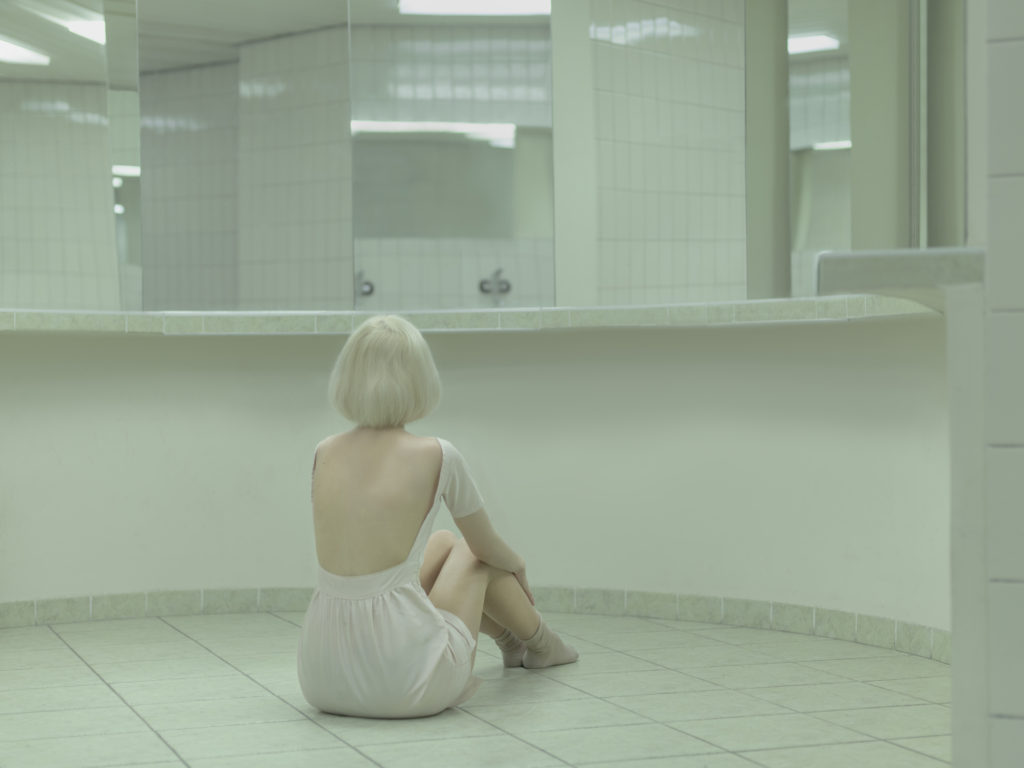
Artificial Tears
− Please tell us about “Artificial Tears”, the main photographic series for this exhibition.
Artificial Tears was created in 2017 after seeing of two great exhibitions, which really influenced my thinking at the time: “Love and Fear” in London and “Artificial tears”-Vienna Biennale,
corresponding with title of this project.
These exhibition consistent of several pieces dealing with future of artificial intelligence, questioning dependency, morality and bias of human beings in relation to this topic. Reaction to such high
form of technology is often combination of exactly – love and fear. At the same time we hope for our salvation but fear downfall and domination over humankind. AI proves us to be creators of
something powerful yet frightening, makes man feel divine but also fragile and mortal, replaceable by a device.
This problematic opens infinite number of question but one issue in particular captured my attention. In all the dilemmas and discussion we draw a division between us and them, or even it as
object of our creation. As if we forget that real progress can provide the absolute union of these two species into the state where any recognition based on difference can become so blurred that it
will be impossible to state on which side you stand. The definition of what does it mean to live or just to function can be easily reshaped even if we shift the focus from origin (how I/it comes to
existence?) to purpose (why I/it comes to existence?) of creation. What is a difference between human and machine?
My vision of future is very elegant and clean. Reality is just a blank canvas on which we project. Nothingness of world we see suggests that everything is happening inside, in the mind, process (or)
of thinking. Main character takes the classical female appearance based on perfection and stereotype. It represents the woman designed (by others or herself) to satisfy general definition of her
kind. Who is it? This model is nobody. Everybody. This model is you as it is me. But also none of us. It can be Marilyn Monroe. Or Tara the Android. Or a faceless machine. It is the other. Your
double. It is a feeling of being outsider in the strange (yet familiar) world. Forced adaptivity to absurd rule. It is nonsense.
Artificial-tears depict the moment of uncertainty, kind of alienation in most ordinary state of performing a stereotypical (act or given) task. The glimpse of second when the pattern gets broken
and the meaning or more exactly the meaninglessness of ones own action is revealed. It does not necessarily shows the future where machine acts like human but rather, or at the same time the
world in which human acts like a machine.
-今回の展覧会でメインにご紹介させていただいているシリーズ「アーティフィシャル・ティアーズ(人工の涙)」についてお聞かせください。
シリーズ「アーティフィシャル・ティアーズ(人工の涙)」は、2017年に鑑賞した2つの展覧会がきっかけで誕生しました。当時ロンドンで開催されていた「愛と畏怖」と、ウィーンのビエンナーレで開催されていた「ア
ーティフィシャル・ティアーズ」(このシリーズのタイトルと同じ)、この2つの素晴らしい展覧会が、私のアイデアに多大なる影響を及ぼしました。
これらの展覧会は、人工知能の未来、依存への不信、そして人間の道徳と偏見など、いくつかの側面から構成されていました。このような高度なテクノロジーへの反応というのは、まさに愛と畏怖が入り混じったものです。
私達は救いを望むと同時に、人類の滅亡と支配を恐れます。 AIは、私たちが強力でありながらも恐ろしいものを生み出しているのだということを証明し、また、人間に神性を感じさせるだけでなく、代えのきかない脆く儚
い存在でもあると示しています。
この問題からは多くの疑問が生じますが、あることが特に私の関心を引きました。あらゆる議論において、私たちは人間とAI(私たちの創造の対象)との間に一線を引きます。互いの違いに基づく認識が曖昧で どちらの側
に立っているのか判別するのが不可能な状態こそが本当の進歩だということを、まるで忘れてしまったかのように。生きること、あるいは機能することの定義は、起源(私たち/それはどのように在るのか)から目的(なぜ
私たち/それは在るのか)へと焦点を移し、たやすく形を変えてしまいます。人間と機械の違いは一体何でしょうか?
私の未来への展望はとても高貴で純粋なものです。現実は単に私たちが投影しているだけの白いキャンバスに過ぎません。私たちが見ている何もない世界は、すべて私たちの心の中で、または私たちの思考のプロセスの中で
起こっているのです。
メインキャラクターは、完璧さと固定観念に基づいた古風な女性像です。彼女のようなタイプの一般概念にふさわしくデザインされた女性を表しています。それは一体誰なのでしょう?モデルは誰でもないのです。私たち全
員です。このモデルはあなたであり私なのです。しかしまた私たちの誰でもないのです。マリリン・モンローにもなり得るし、アンドロイドや顔のないロボットであるかもしれない。そしてもう一人の自分でもあるのです。
それはまるで奇妙な(しかし馴染みのある)世界で部外者であるというような感覚です。不条理な支配に対して強制された適応性。馬鹿げたことです。
「アーティフィシャル・ティアーズ」は、ステレオタイプの(行為もしくは与えられた)任務を実行する際の、不確かな瞬間や一種の疎外感を描写しています。型が壊れて自分自身の行動の意味、あるいはもっと正確にはそ
の無意味さが露見した瞬間を垣間見ること。それは機械が人間のように振る舞う未来だけを示しているのではなく、むしろ人間が機械のように振る舞う世界を同時に示しているのです。

Artificial Tears

Artificial Tears
-The concept of each series is very unique and impressive, how do you usually come up to these ideas?
I usually say that everything can be interesting, if you have your eyes and mind opened. If you don’t just look but you try to see. I take inspiration from everywhere – the view from window in the
morning, scene on the airport, a news report or piece of trash on the pavement. All what makes me feel, what makes me think, no matter if it is book, conversation or my own dream. There is no
general source, a yet everything is the source. The topic is the starting point, which influences everything else- from research to visual and technical approach, through communication or even
presentation. I don’t have any fixed workflow, as each project needs to be treated differently. I don’t want to rely on something what “worked before” or what “always functions” as this would
directly oppose all my interest in art as well as thinking. I create projects out of curiosity and urgency, in order to explore and learn more about what I consider important. I don’t go for specific
result as everything develops in the process as understanding often takes an unexpected turn. Knowing the topic, as much as time and our capacity allows us, consist of initial steps of searching
and questioning, that happen prior to our interpretation and “the statement” presented to the audience. I often deal with quite general topic but there is always a personal undertone to it. This
can be invisible for many, but for myself experiences, external as well as internal ones, influence what interests me, what I decide to spend my time and life on. In this case, to know the topic
means to know yourself, unlock many hidden chambers and confront memories, misconceptions, fears. Project can become certain self-analysis or even self therapy. But even in these cases I
believe that my story deals with issues, and touch topics another person (whoever it might be) deals with as well.
-あなたの作品シリーズのコンセプトはそれぞれ大変ユニークで印象深いものですが、いつもこういったアイデアはどのように思いつくのでしょうか?
私はいつも、目と心が開かれていれば、すべてが面白いものになると考えています。ただ見ているだけでなく見ようとしているならば。私はあらゆるところからインスピレーションを得ます。朝の窓からの眺め、空港の景
色、ニュース、舗装上のゴミの断片など。本だろうが会話だろうが自分の夢だろうが、私が感じるもの、考えさせるものすべてからです。一般的なインスピレーションの源というものはありませんが、しかしすべてが源なの
です。テーマは起源であり、コミュニケーションやプレゼンテーションを通して、リサーチから視覚的および技術的アプローチに至るまですべてに影響を与えています。各プロジェクトを個別に扱う必要があるため、固定さ
れたワークフローはありません。「以前にやったこと」や「常に機能していること」に頼りたくはありません。これは、芸術や思考への私のすべての関心に直接反するからです。私は、自分が重要だと考えることについてさ
らに探求し学ぶために、好奇心と緊急性からプロジェクトを作成します。理解はしばしば予期せぬ転換を迎え、その過程ですべてが発展するので、私は特定の結果を求めません。時間と能力が許す限りテーマを知るというこ
とは、解釈や解説を鑑賞者に提示する前にするべき 調査と疑問 という最初のステップなのです。私は時々非常に一般的なテーマを扱いますが、常に個人的な裏話があります。これは多くの人にとっては見えないかもしれま
せんが、私にとって、経験は(内的なものも外的なものも同様に)私が興味を持っているもの、私が自分の時間と人生を費やすことを決めたものに影響しています。この場合、テーマを知ることは、自分自身を知ること、多
くの隠れた部屋の鍵を開けること、そして記憶、誤解、恐怖に立ち向かうことを意味します。プロジェクトは、特定の自己分析や自己療法にさえなります。

Artificial Tears

Artificial Tears
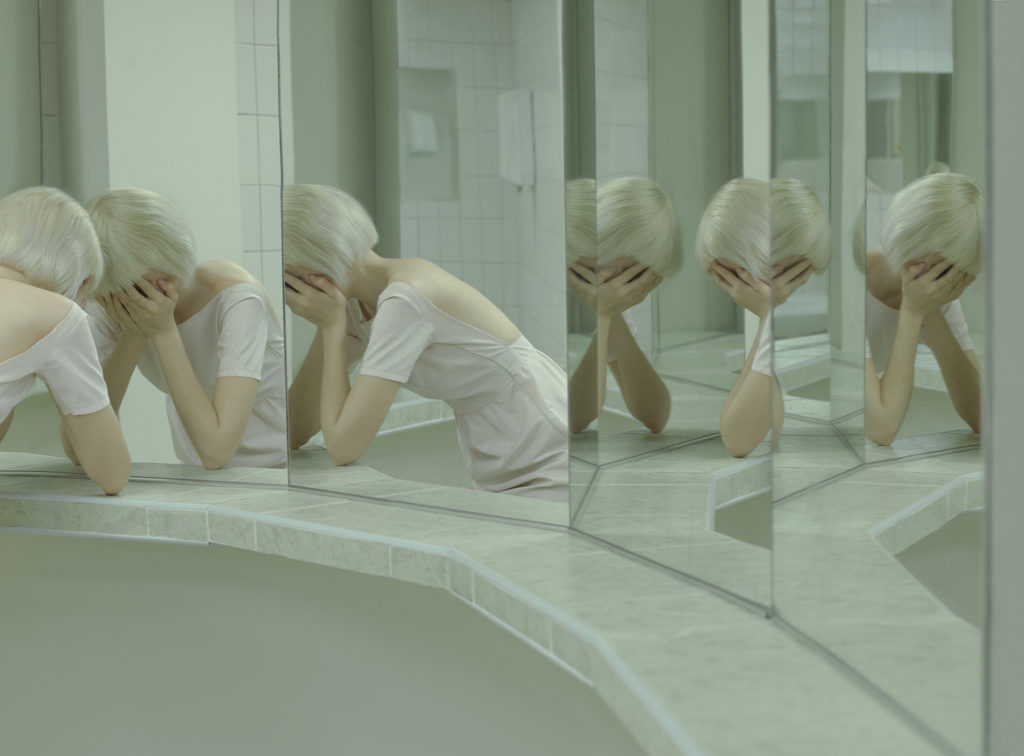
Artificial Tears
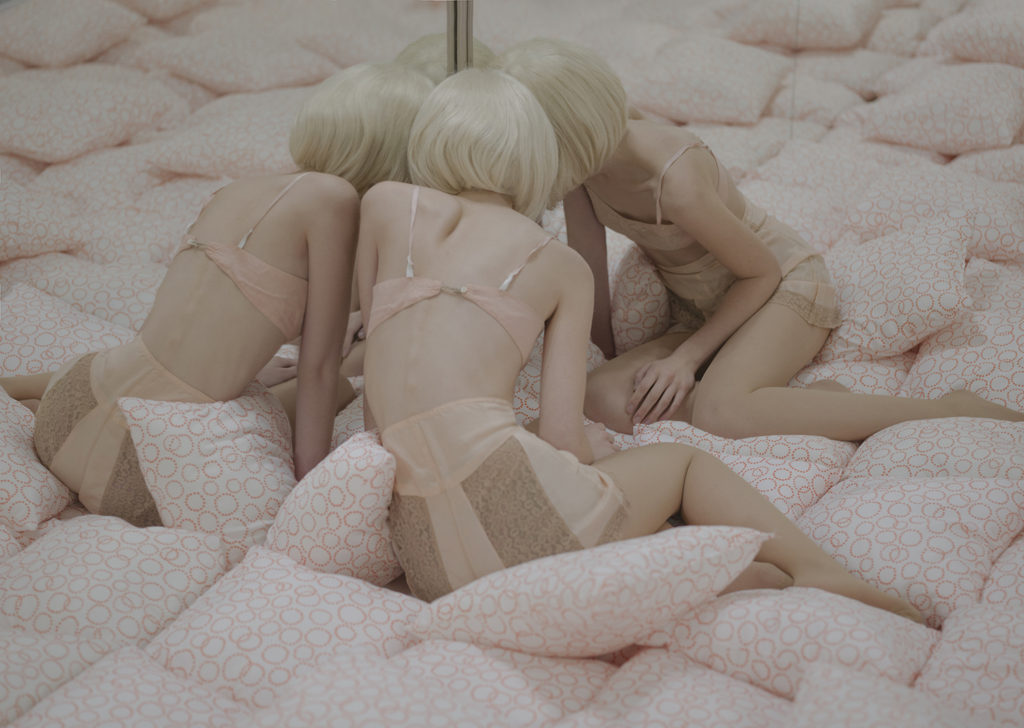
Artificial Tears
-In many of your works, I can see grey-ish tones with tranquil atmosphere. What makes you have this preference of colors or tones you use?
It is surprising for me, that I get this question quite often:) I don’t try to follow one significant style, depending on the project color tones develop quite naturally, more as a result of intuition than
planning. Even though, If I should use some words to define it, I guess I prefer washed out colors that create the atmosphere between past and future but not entirely present. You can see that
there was a clear tone before, your brain can recognize it but not entirely as everything is covered in certain layer. That can be dust, the data dust, memory loss, the though that is distant and
blurred. The scenes I try to create are timeless, often do not belonging to any specific era, no particular place (with exceptions), maybe just the area between dream and reality, abstract vision and
memory, which I often call fiction based on truth.
-あなたの作品には、全体的にグレーがかったような落ち着いた雰囲気が見られますが、このような色やトーンのこだわりを持つようになった理由は何かありますか?
このような質問を良くいただくので驚いています。特に意味のある様式に従っているわけではなく、プロジェクトによっては計画よりも直感の結果として自然と色調が決まることもあります。それでも、言葉を使って定義す
る必要があるならば、過去と未来の間のしかし現在ではないというような 曖昧な雰囲気を作り出すために、冷めたような色彩を好む傾向があるのだと思います。かつては明るいトーンがあったはずですが、すべてが特定の
レイヤーで覆われているため、脳はそれを完全には認識できません。それは砂塵、データの砂塵、記憶の薄れであり、遠くぼやけています。私が創り上げる場面は時代を超越しており、特定の時代に属さず、特定の場所(例
外を除く)を持たないのです。おそらく、私がよく 真実に基づくフィクションと呼んでいる、夢と現実の間の、抽象的な映像と記憶にすぎないのだと思います。
-What do you consider is the most important thing when creating your works?
Probably an ability to express and to interpret often feeling rather than a real event. Photographs are for me like frames of the movie, it is stillness but you feel it moving. It continues in ones
imagination. I would like to inspire the viewer to search for more than what is seen on the surface. Visual is just first layer, which should lead further, deeper. I would like the viewer to think, not
about the correct meaning, as there is no “right” and “wrong”. Image morphs, changes depending on who is looking. It is not only about the work or about me; it is about you as well. Like a mirror,
it reflects. Rather than offering a guideline I would like to ask a question: What do you see? How do you feel? And why? The message works stronger, if you find it yourself, in yourself. Some people
don’t try to go there, but I create for the ones, who do.
-作品制作において、最も重要と考えていることは何ですか?
おそらく、表現力と、実際に起こった出来事というよりもその感情を演出することだと思います。私にとって、写真というのは映像の背景のようなもので、静であるのに動を感じるものです。想像の中で続くものです。私は
鑑賞者に、表面的に見えるもの以上のものを探してもらいたいと考えています。見た目は単なるレイヤーに過ぎず、より遠く深くへと導くものです。鑑賞者には、正しい意味というわけではなく、ただ考えて欲しいと思って
います。良いも悪いもないのだから。画像の形というのは、誰が見ているかによって変わります。作品や私だけでなく、あなたについても同じです。鏡のように、それは反射します。ガイドラインを提供するのではなく、疑
問を投げかけたいと思います。何が見えますか?気分はどうですか?それはなぜ?メッセージは、自分で見つけた場合、より強く自分の中で機能します。そこに行こうとしない人もいますが、私はそうする人のために作品を
制作します。
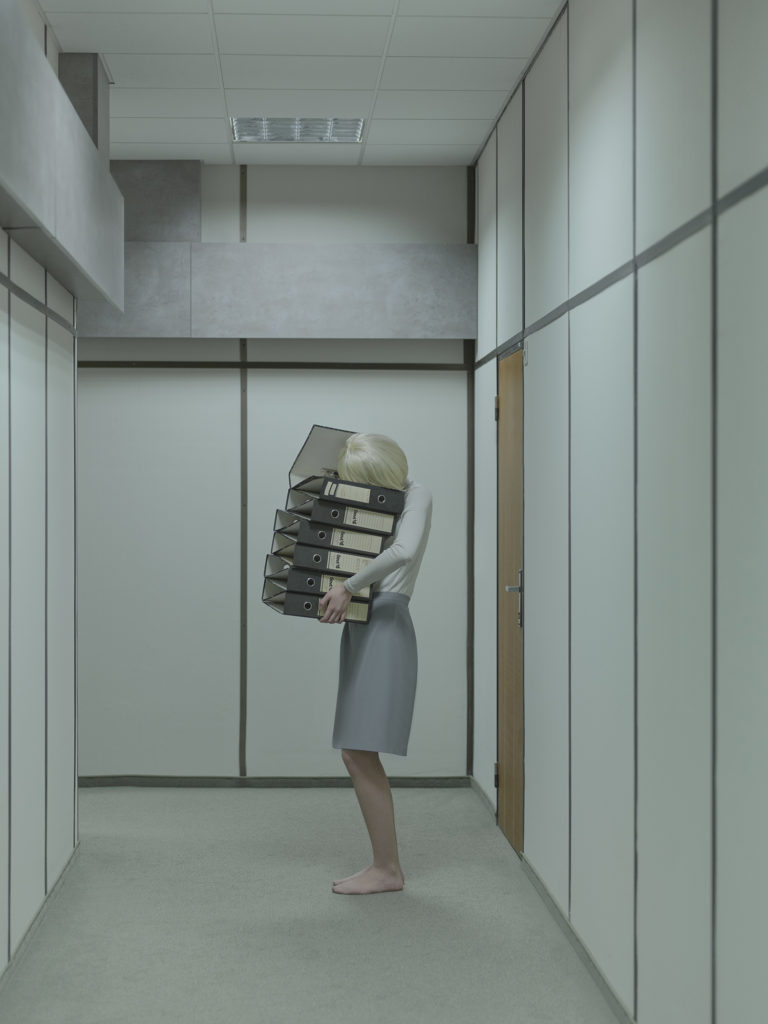
Artificial Tears

Artificial Tears
–Are you mainly working as an artist? Or do you place a great deal of weight on editorial, advertisement and other commercial works?
My personal perspective is, that I work as an artist even when being involved in commissioned project. I chose collaborations, which offer platform for creative expression following values I believe
in. But overall, this is a topic I really care about.
Completing education in classical fine art, I often observed huge wall separating art and commerce in minds of many people. But I always preferred building bridges to walls:) In any work I try to
pursue a point where conceptual meets visual, supporting rather than opposing each other. I believe in art that is intellectual as well as approachable to wider audience, which does not exclude but
connects people. This does not mean, that the work is not challenging, overall I’m not interested in purely decorative visual, but understanding should not be limited by academic background,
language and (often) coming from that, by social class. At the same time, commissioned project, which have higher chance to reach the mainstream (like campaigns and magazine editorials) ought
to follow the same rule and address its audience – not by simplified, empty messages with only goal – to sell a product. Commerce has a big power, as it is everywhere and “for everyone” to
influence public thinking, taste and opinion and I believe this power should be used in meaningful way. I like to include critical or rather reflective message on the most unexpected places hoping
that someone would notice- not the dress, but who is the woman wearing the dress, where does she stand and why is she pictured like this. I don’t agree that, people only see what they know.
Maybe sometimes they know much more than they think and this should be definitely triggered.
-普段は主に写真アーティストとし活動されているのでしょうか?それともエディトリアルや広告など、コマーシャルのお仕事に比重を置いていらっしゃるのでしょうか?
個人的な観点では、委託されたプロジェクトに参加しているときでさえ、私はアーティストとして仕事をしているつもりでいます。私は、自分が信じる価値観に従い、創造的な表現のためのプラットフォームを提供するコラ
ボレーションを自ら選択したのです。しかし、概して、これは非常に気になっているトピックです。
古典芸術の教育を終えて、多くの人々の心にアートと商業を隔てる大きな壁があることを知りました。しかし、私は常に壁に橋を架けることを望みました。どんな仕事においても、私は概念が視覚に出会うポイントを追求し
ようとしています。私は、芸術が知的で、幅広い鑑賞者に親しみやすいもの、そして人々を除外するのではなく結びつけるものであることを信じています。これは、作品が挑戦的ではないということを意味するものではな
く、概して純粋に装飾的なビジュアルには興味がありませんが、「解釈」は学歴、言語、およびそれらから来る(多くの場合)社会階級によって制限されるべきではありません。同時に、主流に近づく可能性が高い委託キャ
ンペーン(または雑誌の編集など)は、同じルールに従い製品を売るという目標を掲げた単純化されたメッセージではなく、その都度その対象者に対応する必要があります。商業というのはどこにでもあって、世論や好み・
意見に影響を与える「すべての人のためのもの」であり、大きな力を持っています。そして、この力は意味のある方法で使用されるべきだと私は思います。
私は、誰かがドレスにではなく、ドレスを着ている女性が誰なのか、彼女がどこに立っているのか、なぜ彼女がこのように描かれているのか、ということに気が付くことを期待して、最も予想外の場所に批判的もしくは反映
的なメッセージを含めるのが好きです。人々が知っていることしか見ることができないということには納得できません。たぶん、時に人は思っている以上に多くのことを知っていて、このような気づきは間違いなく引き起こ
されるはずです。

Artificial Tears
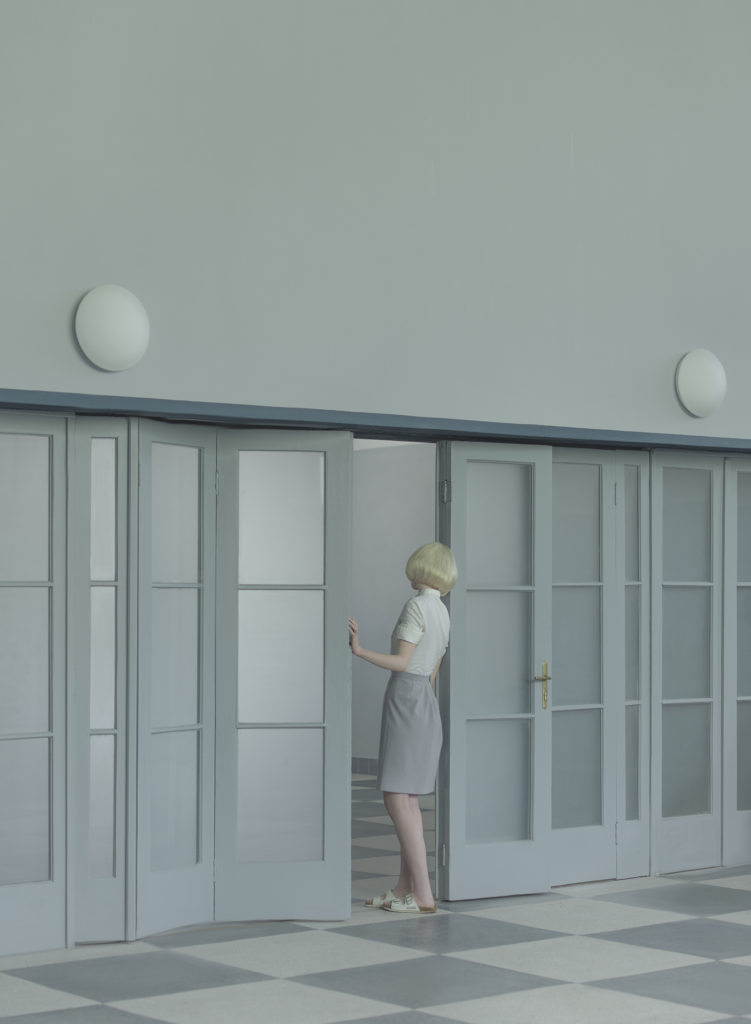
Artificial Tears

Artificial Tears
– You seem to be very young, but how do you feel to be one of the successful photographers at your age?
I don’t consider myself successful as I’m still far from reaching many personal goals. All I do, is work in progress, the process that did not yet arrived to desired destination. It does not sound grand,
but it is truth. I feel comfortable in this position, as I know it is not static. We all have different definitions of success, and overall I find this word, and the pressure of current society on such terms
quite poisonous and harmful. My goal cannot be measured by likes or paid out in cash, in comes from within, from knowledge that I can create something what really matters, for myself as well as
for others. It is precious to have the voice, which is heard but it comes with responsibility of delivering an important message, to be able to use such an opportunity well and wisely. For that reason
I’m patient, and even though I can call myself ambitious it is more about growth and development than about success.
Maybe I answered in expected way, but I give a lot of though to broken values society tries to impose on artist and overall on people. In general, I don’t feel young or old, I guess it relates well to the
1st paragraph of this answer. I’m aware that I’m lacking some skills as well as wisdom that come with time and experience, but it is natural for the stage I’m at in my career and life.
-あなたは大変お若いですが、今の年齢での写真家としての成功をどのようにお感じですか?
私にはまだ達成したいたくさんの個人的な目標がありますので、自分が成功しているとは思っていません。私がしていることは、進行中の作業、まだ目標の目的地に到着していない過程の段階です。それは壮大には聞こえま
せんが、事実なのです。止まっているわけではないことをわかっているので、このポジションを快適に感じています。私たちは皆、成功についてさまざまな定義を持っています。概して、私はこの言葉と、そのような用語に
対する現在の社会の圧力が、非常に有毒で有害であると思っています。私の目標は、自分だけでなく他の人にとっても本当に重要なものを制作したいという感情から成るものですから、自分の好みやお金で推し量れるもので
はありません。そのような機会を上手に賢く使えるようにするために、意見を聞くことは大切だと思いますが、それは重要なメッセージを伝える責任を伴います。ですから、私は辛抱強く、自分自身を野心的と呼ぶことはで
きますが、成功よりも成長と発展に対してのものです。普段、私は若いとも年をとっているとも思っていません。この質問の答えの最初の1行と関係していると思います。時間と経験に伴うスキルや知恵が不足していること
は承知していますが、自分のキャリアや人生の段階としては当然のことです。
-Do you have any particular preference regarding cameras (equipment) you use?
Equipment is not so important for me. My attention goes to the message rather than technical execution of it. Of course, it is helpful to be skilled and know “the rules” in order to break them or
even to forget them. All depends on approach you want to take:) I use digital, analogue, or even shoot on the phone, whatever the project or particular moments requires. My main camera is
Hasselblad H5-50c since I won Hasselblad Masters prize in 2016.
-使用しているカメラ機材にこだわりはありますか?
機材は私にとって重要ではありません。私の関心は技術的なことよりもメッセージにあります。もちろん、技術があることは大変な助けになりますし、破るためもしくは忘れるためにルールを知ることも重要です。どんなア
プローチをするかに全てはかかっています。私は、デジタルもアナログも使用しますし、携帯で撮影することもあります。そのプロジェクトや特定の瞬間に必要なものを使用します。メインのカメラは、ハッセルブラッドの
H5-50cです。2016年にハッセルブラッドのマスターズアワードを受賞しましたので。

Faceless

Faceless
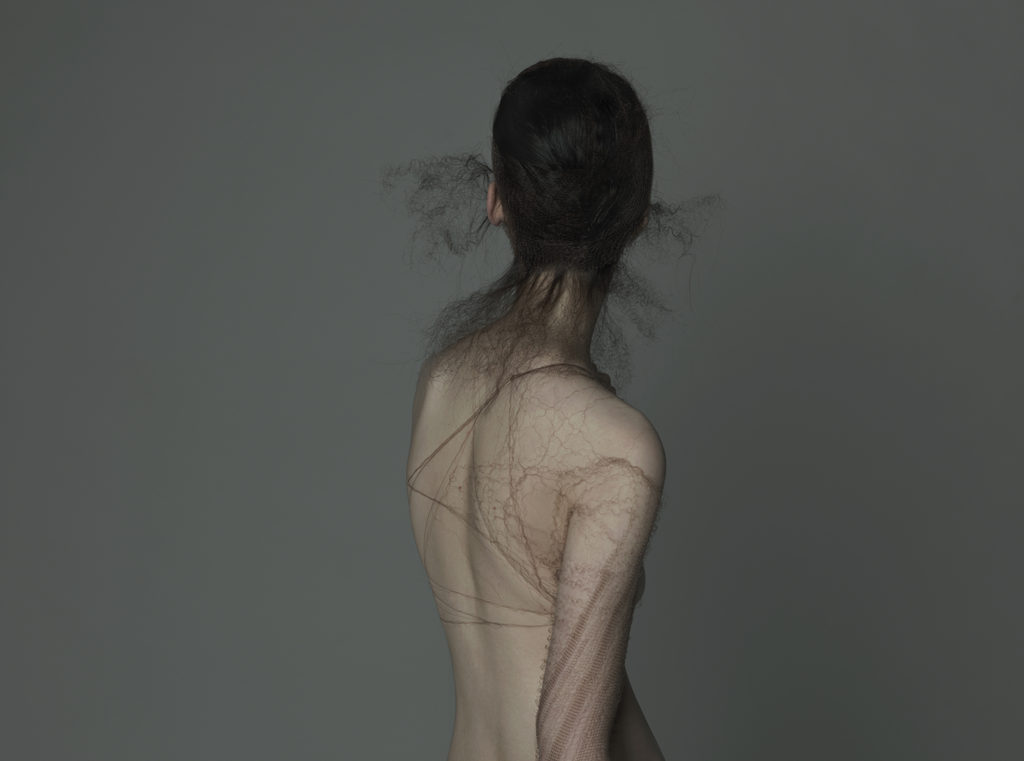
Faceless
–Do you have any favorite photographer/artist or photographer who gave you an influence on your work?
I believe in positive power of references if not working as boundaries of independent thinking. In the end, your own opinion and standpoint is the most unique and valuable quality, which artist can
have. But still, these opinions are formed by all the external factors. By personal point of view artists are able to question and reinterpret pieces already created as well as grasp same topic, same
visual concept and view it from different angles, creating more general, objective message for the audience. We can usually observe certain likeness, slight similarity in work produced in specific
time or region of the world. That is not necessarily copying, but sharing references that come from same origin and by this actually reflecting on social and cultural setting or actual situation. In
this sense, artwork produced becomes more than individual, it leaves a certain legacy as voice multiplied, articulating the topic, and it sounds louder. This is the point where personal motivation
grows into movement, and message of works develop into discussion of many. Sharing, inspiring and learning from each other is important in art, as well as in any field. To deny this in sake of
individual originality, which is almost unreachable would be a pity for photography as well as art, and at the end whole world.
I’m a fusion of all the things I saw, heard or experienced. All these impulses mix together into something what can be called imagination and taste. Inspiration is your own choice of influence, so I
would advise anyone to carefully choose your sources, because similarly as in diet, you become what you eat:)
People I admire come from different spheres like film (Roy Anderson, Andrzej Zulawski), music or historic classical art … there are actually too many to mention just few:) I also take a lot of
inspiration from reading which fuels my imagination even more than visual. What connects all my references is, that I’m always interested in the creator of the piece- the personality, story and
motivation- bigger picture that unfolds behind the artwork. Generally I admire those with full dedication, honest approach and desire or courage to break patters of thinking as well as social
barriers in any field of society not only reduced to art and culture.
-お好きな写真家やアーティスト、またご自身の作品に影響を与えた写真家はいらっしゃいますか?
私は、独自のアイデアで制作をしない場合、何かを参考にするというのはポジティブなことだと思います。最終的には、自分自身の意見と立場は、アーティストが持つことができる最もユニークで価値のあるものです。それ
でも、このような考え方はすべて外部要因によって形成されます。個人的な観点から言うと、アーティストは、既に作成された作品に疑問を投げかけ再解釈し、同じトピックや視覚概念を把握し、異なる角度からそれらを見
て、観客に対してより一般的で客観的なメッセージを制作します。私たちは通常、特定の時間や場所で制作された作品のわずかな類似性を見つけることができます。それは必ずしもコピーではありませんが、同じ起源からの
参照を共有し、これにより実際に社会的および文化的環境または実際の状況を反映しています。この意味で、制作された作品は個々のものよりも多くなり、意見が増加することでトピックが明確になり、特定の遺産を残しよ
り大きく聞かれるようになります。これは、個人のモチベーションが活動へと成長し、作品のメッセージが多くの議論に発展するポイントです。芸術や他の分野では、お互いに共有し、刺激を受け、学ぶことが重要です。個
人の独創性のためにこれを否定することは、ほぼ不可能なことですが、写真だけでなくアート、そして最後には全世界にとっても残念なことです。
私に影響を与えているのは、私自身が見たもの・聞いたもの・経験したものすべての融合です。これらの衝動はすべて一緒になって、想像力と嗜好と呼ばれるものになります。インスピレーションは自分自身の影響力の選択
ですので、食事と同様に自分が食べるものになるので、私は皆さんにソースを慎重に選ぶことをお勧めします!
私が尊敬する人たちは、映画(ロイ・アンダーソン、アンドレイ・ズラウスキ)、音楽、歴史的古典的芸術など、さまざまな分野にいます。数え切れないほどいますので挙げることが難しいです。読書からも多くのインスピ
レーションを得て、視覚よりも想像力をさらに高めています。私のインスピレーションすべてを繋いでいるのは、作者への興味です。作品の創作者のパーソナリティ、歴史、そして動機に常に興味を持っています。通常、私
は、芸術と文化に還元されるだけでなく、社会のあらゆる分野において、思考のパターンや社会的障壁を打破するために献身し、誠実なアプローチをしている、その欲求と勇気を持つ人々を賞賛しています。

Faceless

Faceless

Faceless
-Are you interested in Japan? Any Japanese Photographer/Artist you know?
Definitely! I’m fascinated by Japanese art and culture, whether it is traditional ink painting, Butoh dance or sound of Ryoji Ikeda. But I’m very eager to visit Japan one day (hopefully soon) and
get to know much more!
-日本に興味はありますか? 知っている日本人写真家・アーティストはいますか?
もちろんです!日本のアートや文化は魅力的です。伝統的な墨絵や舞踏、そしてミュージシャン池田亮司氏のサウンドも。いつか絶対に(できればすぐに)日本に行って、もっと色々と知りたいです!
-Please tell us if you have something you want to do in the future or any project you already have in mind.
Stay curious. Keep searching. Discover more and more… and I guess that is all:)
-今後やってみたいことや、すでに考えているプロジェクト等があれば教えてください。
好奇心旺盛でいること。探求し続けること。もっともっと発見すること。それが全てだと思います。
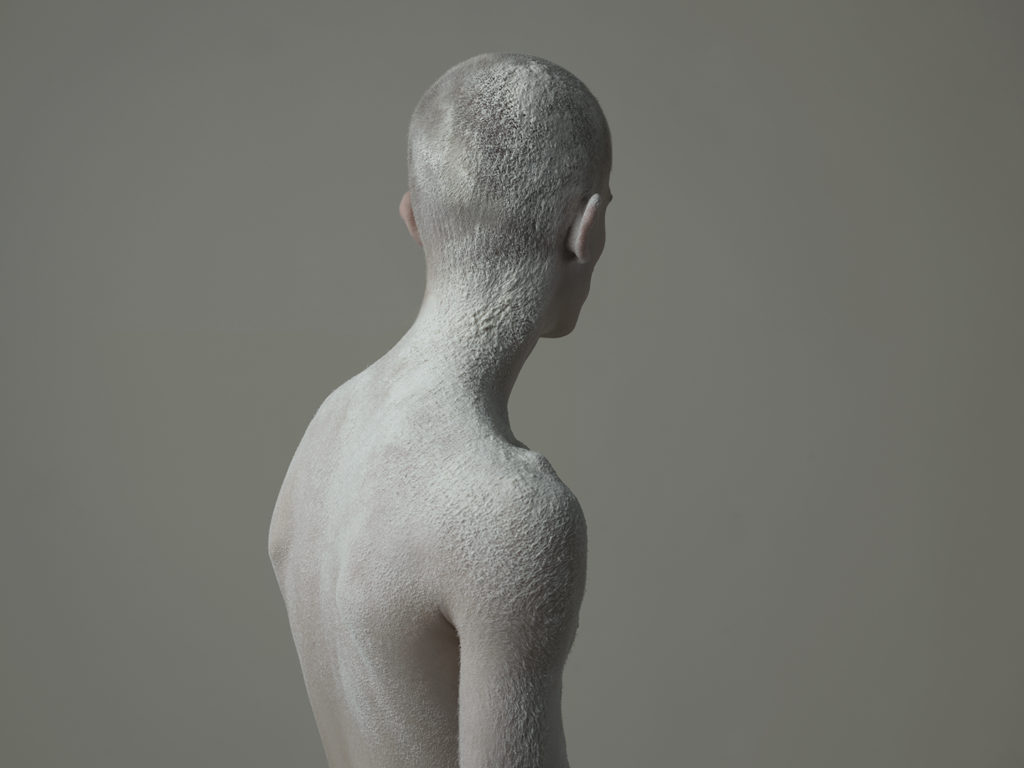
Faceless

Evelyn Bencicova (b. Bratislava, 1992) is a visual creative specialising in photography and art direction. Informed by her background in fine art and new media studies (University for Applied Arts,
Vienna), Evelyn’s practice combines her interest in contemporary culture with academic research to create a unique aesthetic space in which the conceptual meets the visual.
Depicting multifaceted representations as illusions, Evelyn plays with the viewer’s perception to entice them into the secret labyrinth of her imagination. Her disturbingly beautiful visual language
and washed-out colour palette, set within curiously symbolic environments, allow for a deep exploration of the themes that take her images far beyond what they reveal at first glance.
Evelyn’s client repertoire includes fashion and luxury brands such as Gucci and Nehera, as well as cultural institutions such as Frieze, Berghain, Kunsthalle Basel, Royal Opera House, Slovak National
Theatre and Ballet and Museums Quartier Vienna. Bencicova was invited to create visuals for the Institute of Molecular Biology in Austria, and to perform at Atonal Berlin several times.
Evelyn’s commercial and artistic projects have been featured in the likes of Vogue Portugal, Vogue Czechoslovakia, ZEIT Magazine, Dazed & Confused, GUP, HANT and Metal Magazine. Her work
has been published in prestigious international photography books and on several online platforms (Juxtapoz, iGNANT.com, Fubiz media) and she has participated in solo and group exhibitions
across Stockholm, London, Tokyo, Paris, NYC, Berlin, Vienna, Milan, Amsterdam, Brussels, Prague and Rome.
In 2016, Bencicova received the prestigious Hasselblad Masters and Broncolor GenNext awards. She was shortlisted and awarded by LensCulture, Independent Photographer, Gomma Grant, Life
Framer, Tokyo International Photo Award and OFF Festival. Evelyn was selected as one of 30 under 30 Female photographers by Artpil.
イブリン・ベンチコヴァ(ブラチスラヴァ・スロバキア1992年生まれ)は、写真とアートディレクションに特化したアーティストです。ファインアートとニューメディア研究(ウィーン応用美術大学)を学んだ背景から、
イヴリンは作品制作において、学術研究と現代文化への関心を結びつけ、概念とヴィジュアルが融合する独自の美的空間を創り出しています。
多面的かつ象徴的な表現を幻想として用いて、鑑賞者の意識を刺激し、彼女の想像の中の秘密の迷路に誘います。奇妙で象徴的な環境下で設定された彼女の不穏なほど美しい視覚言語と洗い流されたパレットが、初見の印象
をはるかに超えた作品テーマへの深い探求を可能にしています。
クライアントには、オペラハウスや国立劇場、美術館などの文化施設だけでなく、グッチやカルティエなどのファッションブランドも含まれています。2018年初め、ベンチコヴァはオーストリア分子生物学研究所のヴィジ
ュアル制作や、ベルリンの音楽フェスティバルの閉会式でのパフォーマンスを依頼されました。
広告作品やアート作品は、以下のような媒体に掲載されました。
ポルトガル版Vogue、チェコスロバキア版Vogue、韓国版Vogue、ZEIT Magazine、The Gentlewoman、ELLE、Dazed & Confused、GUP、HUNT、Metal Magazineなど。
また彼女の作品は、国際的に名高い写真紙やウェブサイト等でも取り上げられ、さらにストックホルム、ロンドン、東京、パリ、ベルリン、ウィーン、ミラノ、アムステルダム、ブリュッセル、プラハ、ローマなどでは個展
やグループ展が開催されています。
2016年、高名なハッセルブラッド&ブロンカラー GenNext アワード受賞。レンズカルチャーのインデペンデントフォトグラファーアワードのファイナリストに選出され受賞、その他Gomma Photography Grant, Life
Framer, 東京インターナショナル写真アワード、OFF Festivalにて受賞。また、Artpilによる30代の女性写真家30人にも選出されている。


